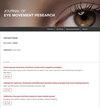Behind the scenes: Impact of virtual backgrounds in educational videos on visual processing and learning outcomes
IF 2.8
4区 心理学
Q3 OPHTHALMOLOGY
引用次数: 0
Abstract
The increasing use of instructional videos in educational settings has emphasized the need for a deeper understanding of their design requirements. This study investigates the impact of virtual backgrounds in educational videos on students' visual information processing and learning outcomes. Participants aged 14-17 (N=47) were randomly assigned to one of three conditions: a video with a neutral, authentic, or off-topic background. Their prior knowledge and working memory capacity (WMC) were measured before watching the video, and eye tracking data was collected during the viewing. Learning outcomes and student experiences were assessed after viewing. The eye tracking data revealed that a neutral background was the least distracting, allowing students to pay better attention to relevant parts of the video. Students found the off-topic background most distracting, but the negative effect on learning outcomes was not statistically significant. In contrast to expectations, no positive effect was observed for the authentic background. Furthermore, WMC had a significant impact on visual information processing and learning outcomes. These findings suggest that educators should consider using neutral backgrounds in educational videos, particularly for learners with lower WMC. Consequently, this research underscores the significance of careful design considerations in the creation of instructional videos.幕后:教育视频中虚拟背景对视觉处理和学习结果的影响
在教育环境中越来越多地使用教学录象,强调需要更深入地了解其设计要求。本研究探讨了虚拟背景对学生视觉信息加工和学习效果的影响。年龄在14-17岁的参与者(N=47)被随机分配到三种情况中的一种:中性、真实或离题背景的视频。在观看视频前测量他们的先验知识和工作记忆容量(WMC),并在观看过程中收集眼动追踪数据。学习成果和学生体验在观看后进行评估。眼动追踪数据显示,中性背景最不容易分散注意力,能让学生更好地关注视频的相关部分。学生发现离题背景最容易分散注意力,但对学习成果的负面影响在统计上并不显著。与预期相反,真实背景没有观察到积极的影响。此外,WMC对视觉信息加工和学习结果有显著影响。这些发现表明,教育工作者应该考虑在教育视频中使用中性背景,特别是对于低WMC的学习者。因此,本研究强调了在教学视频创作中仔细设计考虑的重要性。
本文章由计算机程序翻译,如有差异,请以英文原文为准。
求助全文
约1分钟内获得全文
求助全文
来源期刊

Journal of Eye Movement Research
OPHTHALMOLOGY-
CiteScore
2.90
自引率
33.30%
发文量
10
审稿时长
10 weeks
期刊介绍:
The Journal of Eye Movement Research is an open-access, peer-reviewed scientific periodical devoted to all aspects of oculomotor functioning including methodology of eye recording, neurophysiological and cognitive models, attention, reading, as well as applications in neurology, ergonomy, media research and other areas,
 求助内容:
求助内容: 应助结果提醒方式:
应助结果提醒方式:


